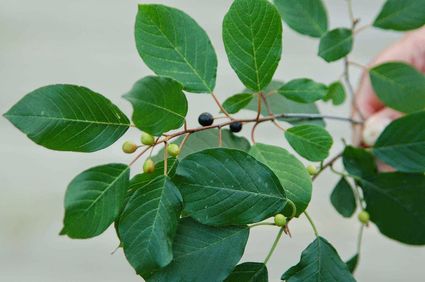SWCD News: The time is now to get rid of buckthorn
October 9, 2020
As winter approaches, you may think your outdoor projects are done for the year, but if you have buckthorn removal on your list of chores, late fall and early winter are great times to get it done.
Why is buckthorn bad?
There are many reasons this invasive, non-native shrub is better taken out than left to take over our native woodlands.
• Competes and crowds out native plants for nutrients, light, and moisture
• Degrades important wildlife habitat and food sources
• Can host pests, such as crown rust fungus and soybean aphids
• Contributes to erosion by outcompeting with plants on the forest floor that help hold soil in place
• Forms an impenetrable, messy layer of vegetation
• Seeds can stay viable in the soil for up to three years
The characteristics of buckthorn:
• Egg-shaped leaves that stay green into late fall (even after all other trees have lost their leaves)
• Large, round berry-like clusters of black ¼-inch fruit on female trees
• Bark is brown with elongate silvery corky projections, similar to native plums or cherries
• Cut branch exposes yellow sapwood and orange heartwood
• Height of up to 25 feet
There are several ways to remove your buckthorn, depending on what the plants look like, and how dense they are on your property. It's important to note, that regardless of how you remove the buckthorn from your yard, you must follow up next seasons with additional removal if necessary. Buckthorn is tricky; its seeds can stay viable in the ground for up to five years.
Removing small clusters
For small clusters of buckthorn - stem diameter of 2 inches wide or less - rip them up by hand or with a buckthorn removal weed wrench. Be sure to rip up the entire stem and root system. Simply cutting the stem at the ground level will still allow buckthorn's tough roots to continue growing.
Removing large bushes
Weed wrenches are not strong enough to excavate buckthorn larger than 2 inches in diameter. To successfully remove it requires cutting at its base at the soil surface, whether with a chainsaw, axe, or handsaw - whatever you have available. Once the base of the plant is removed, treat the stump with herbicide to kill the root systems below.
Now that your pesky buckthorn is out of the way, it is time to plant something native and beautiful. Think about replacing that now-open space with Minnesota-native trees and shrubs. Contact the Carlton SWCD at (218) 384-3891 or carltonswcd.org to learn more.
Alyssa Alness is a SWCD conservation specialist.







